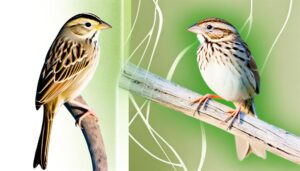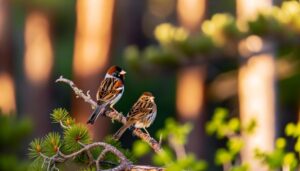10 Key Differences: House Sparrow Vs Chickadee
House Sparrows (16 cm, 21-26 cm wingspan) display brown/grey plumage with a black bib and possess a thick, robust bill. They thrive in urban areas, feeding primarily on grains and seeds with 10% insects.
Chickadees (12-15 cm, 17-21 cm wingspan) have a black cap, white cheeks, and a greyish body, favoring wooded areas and a diet consisting of 50% insects. They exhibit cooperative foraging and intricate vocalizations ranging from 2-10 kHz.
House Sparrows are aggressive and maintain dominant-subordinate hierarchies, while Chickadees have egalitarian social structures. Each species offers unique insights into avian ecology and behavior, awaiting further exploration.

Key Takeaways
- House Sparrows have a robust bill and prefer urban habitats; Chickadees have a conical bill and favor wooded areas.
- House Sparrows are larger, with a 21-26 cm wingspan; Chickadees have a smaller 17-21 cm wingspan.
- Chickadees consume more insects, about 50% of their diet, while House Sparrows primarily eat grains and seeds.
- House Sparrows are aggressive and competitive; Chickadees are cooperative with complex vocalizations.
- House Sparrows nest in building crevices, while Chickadees use natural tree cavities or nest boxes.
Physical Characteristics
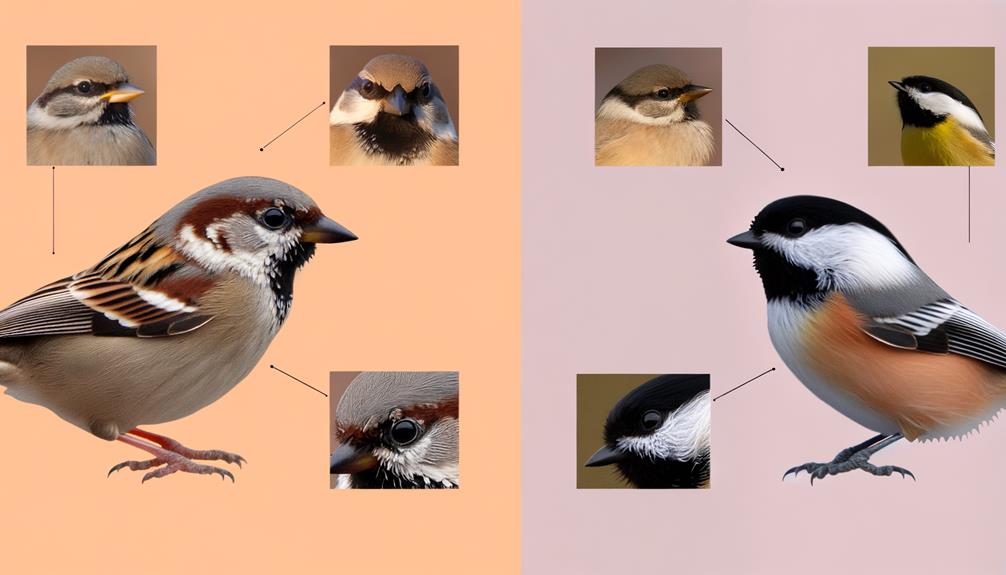
When comparing the physical characteristics of the House Sparrow (Passer domesticus) and the Chickadee (Poecile spp.), one observes distinct differences in size, coloration, and morphological features.
House Sparrows typically measure around 16 cm in length with a wingspan of 21-26 cm, exhibiting a robust build. Their plumage is mainly brown and grey, with males displaying a distinctive black bib.
Conversely, Chickadees are smaller, averaging 12-15 cm in length with a wingspan of 17-21 cm. They possess a more petite frame and are characterized by their black cap, white cheeks, and greyish body. Additionally, the Chickadee's bill is shorter and more conical compared to the House Sparrow's thicker, more robust bill.
Habitat Preferences
In addition to their distinct physical characteristics, House Sparrows and Chickadees exhibit different habitat preferences, with House Sparrows commonly found in urban and suburban environments, while Chickadees favor wooded areas and forest edges.
House Sparrows are often observed nesting in eaves and building crevices, foraging in parks and gardens, congregating near human dwellings, and utilizing bird feeders in residential areas.
Chickadees, on the other hand, prefer habitats characterized by dense foliage for cover, availability of tree cavities for nesting, proximity to deciduous and mixed forests, and the presence of understory vegetation.
These observations indicate that while House Sparrows thrive in human-altered landscapes, Chickadees seek more natural, forested environments, demonstrating their distinct ecological niches.
Diet and Feeding

In examining the dietary preferences of the House Sparrow (Passer domesticus) and the Chickadee (Poecile atricapillus), one observes distinct variations in their primary food sources.
House Sparrows consume a diet primarily comprising grains and seeds, with occasional insects accounting for about 10% of their intake.
Conversely, Chickadees exhibit a higher reliance on insects, constituting approximately 50% of their diet, supplemented by seeds and nuts.
Dietary Preferences Compared
House sparrows primarily consume grains and seeds, while chickadees favor insects and spiders, indicating their differing dietary preferences. Observations reveal that house sparrows exhibit a granivorous diet, often foraging in agricultural areas.
In contrast, chickadees display insectivorous tendencies, especially during breeding seasons when protein intake is vital. Dietary analysis shows:
- House Sparrows:
- Prefer cereal grains like wheat and millet.
- Also consume weed seeds and fruits.
- Chickadees:
- Seek caterpillars, beetles, and spiders.
- Occasionally eat seeds and berries, especially in winter.
These preferences highlight their ecological niches. While sparrows impact grain crops, chickadees control insect populations, showcasing their roles in agricultural and natural ecosystems.
Feeding Habits Analysis
Field studies reveal that house sparrows typically forage in flocks, pecking at the ground for grains, while chickadees exhibit solitary or small-group feeding behaviors, meticulously extracting insects from tree bark and foliage.
House sparrows primarily consume seeds and grains, constituting approximately 70% of their diet. They show preference for agricultural fields and urban settings, where food is abundant.
Conversely, chickadees' diet is composed of 80% insects and spiders, which they locate using their acute vision and nimble beaks. Chickadees demonstrate a unique behavior called “cache foraging,” storing food in hidden spots for future consumption.
These contrasting feeding strategies highlight species-specific adaptations, ensuring survival in diverse habitats. Understanding these habits provides insight into avian ecological roles and behaviors.
Behavior and Social Structure
House sparrows exhibit highly organized social structures, often forming flocks that range from 10 to 50 individuals.
Chickadees, in contrast, display more fluid group dynamics, typically associating in smaller groups of 3 to 12 birds.
Behavioral observations indicate that house sparrows engage in frequent competitive interactions, whereas chickadees show a greater tendency for cooperative foraging.
Social Interaction Patterns
Why do House Sparrows and Chickadees exhibit distinct social hierarchies and interaction patterns within their flocks?
House Sparrows (Passer domesticus) form tight-knit groups with clear dominant-subordinate relationships. Their interactions include frequent aggressive displays, pecking orders, and vocalizations.
In contrast, Chickadees (Poecile atricapillus) display more egalitarian social structures, with less overt aggression and more cooperative behaviors.
Key differences include:
- Dominance: Sparrows exhibit linear hierarchies, while Chickadees have more fluid ranks.
- Aggression: Sparrows show higher frequencies of aggressive interactions.
- Communication: Chickadees use complex vocalizations for coordination and alerting.
- Group cohesion: Chickadees exhibit stronger group cohesion during foraging.
These patterns reflect evolutionary adaptations to their respective ecological niches, optimizing survival and resource acquisition.
Group Dynamics
Understanding the group dynamics of House Sparrows and Chickadees involves examining their behavioral interactions and social structures, which reveal significant differences in their foraging strategies, nesting habits, and predator avoidance mechanisms. House Sparrows exhibit a gregarious nature, forming large flocks that enhance communal foraging efficiency and predator vigilance. Conversely, Chickadees display more structured social hierarchies, often observed in smaller, cohesive groups with clear dominance orders. These distinctions impact their day-to-day survival and adaptability in varying environments.
| Aspect | House Sparrows | Chickadees |
|---|---|---|
| Foraging Strategy | Communal | Hierarchical |
| Nesting Habits | Colonial | Solitary/Semi-colonial |
| Predator Avoidance | Flock-based vigilance | Sentinel behavior |
| Social Structure | Loosely organized flocks | Structured dominance |
| Group Size | Large groups | Smaller groups |
This comparative analysis underscores their unique adaptive behaviors.
Vocalizations
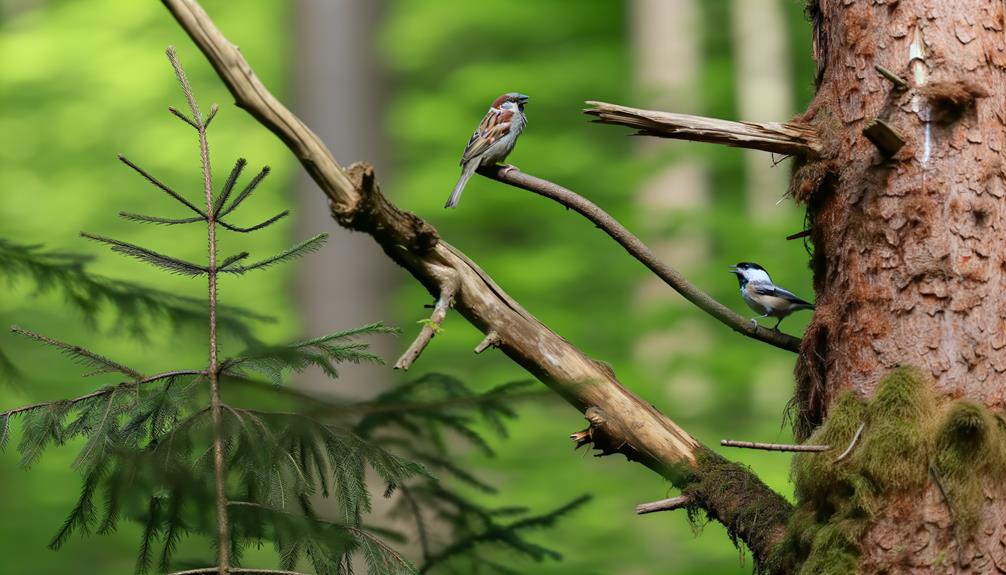
Comparative analysis of vocalizations reveals that house sparrows and chickadees exhibit distinct patterns in frequency, duration, and complexity of their calls. House sparrows typically produce simpler, repetitive chirps, whereas chickadees are known for their diverse and intricate vocal repertoire.
- Frequency: House sparrow calls average around 4-6 kHz, while chickadee calls can range from 2-10 kHz.
- Duration: Sparrow calls are generally short, lasting about 0.5 seconds, whereas chickadee calls can extend up to 2 seconds.
- Complexity: Chickadees use a variety of notes and combinations, often including up to 12 distinct calls.
- Function: Chickadee calls often serve multiple purposes like signaling alarm or coordinating group movement, whereas sparrow calls are primarily territorial.
These differences highlight their unique communication strategies.
Breeding and Nesting
Both house sparrows and chickadees exhibit distinct breeding and nesting behaviors. House sparrows often construct their nests in cavities or building eaves, while chickadees prefer natural tree cavities or nest boxes. House sparrows typically lay 4-6 eggs per clutch, with an incubation period of 10-14 days. Their nests are loosely constructed from grass, feathers, and paper.
Chickadees, on the other hand, lay 6-8 eggs per clutch, incubating them for about 12-13 days. Their nests are meticulously crafted from moss, wool, and animal fur. Both species demonstrate strong territoriality during the breeding season, yet chickadees exhibit a higher fidelity to their nesting sites.
These precise nesting preferences highlight the ecological adaptations and survival strategies of each bird.
Migration Patterns
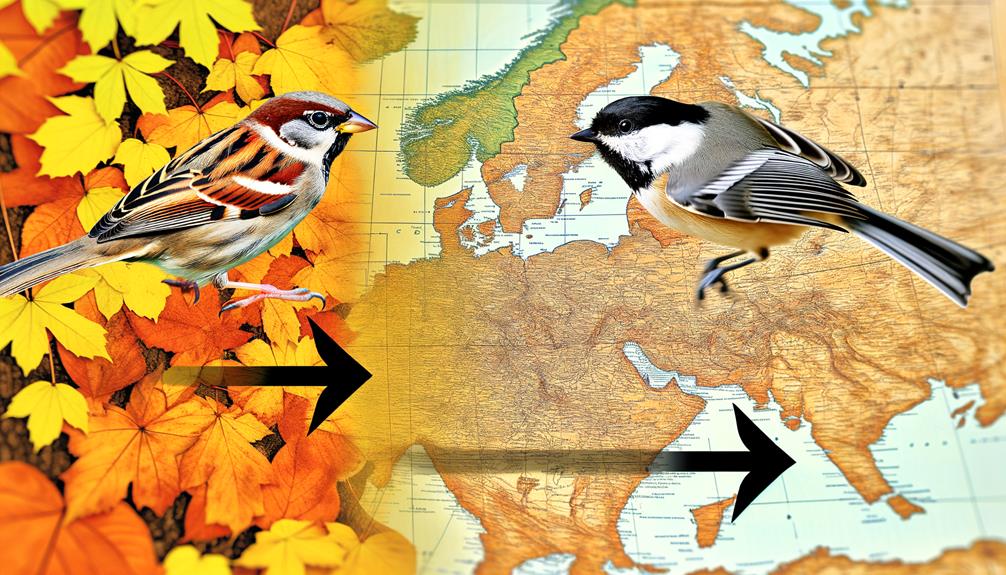
While house sparrows exhibit sedentary behavior, remaining in their territories year-round, chickadees show partial migratory tendencies, often moving short distances in response to harsh winter conditions.
These movements are characterized by specific patterns:
- Distance: Chickadees typically migrate between 50-100 kilometers.
- Timing: Migration occurs mainly from late October to early November.
- Altitude: They may shift from higher elevations to lower ones.
- Group Size: Migratory flocks can range from a few individuals to groups of 30.
House sparrows, in contrast, remain within a 1-2 kilometer radius of their nesting sites throughout the year. Their sedentary nature is advantageous in stable urban environments, allowing them to maintain territories and resources without the energy expenditure associated with migration.
Interaction With Humans
Observing the interaction with humans, house sparrows often exploit urban environments by nesting in man-made structures and foraging on food scraps, demonstrating a high degree of adaptability. They utilize cavities in buildings, eaves, and other architectural features, thriving in close proximity to human activity. Their behavior reflects opportunistic feeding strategies, capitalizing on discarded food and bird feeders.
Chickadees, on the other hand, exhibit less dependence on urban areas, preferring natural habitats like forests and woodlands. Though they frequent bird feeders, their interaction with humans is less invasive.
Chickadees are known for their curiosity and often approach humans for food, yet they maintain a degree of independence by continuing to forage for insects and seeds in their natural environment.
Conservation Status
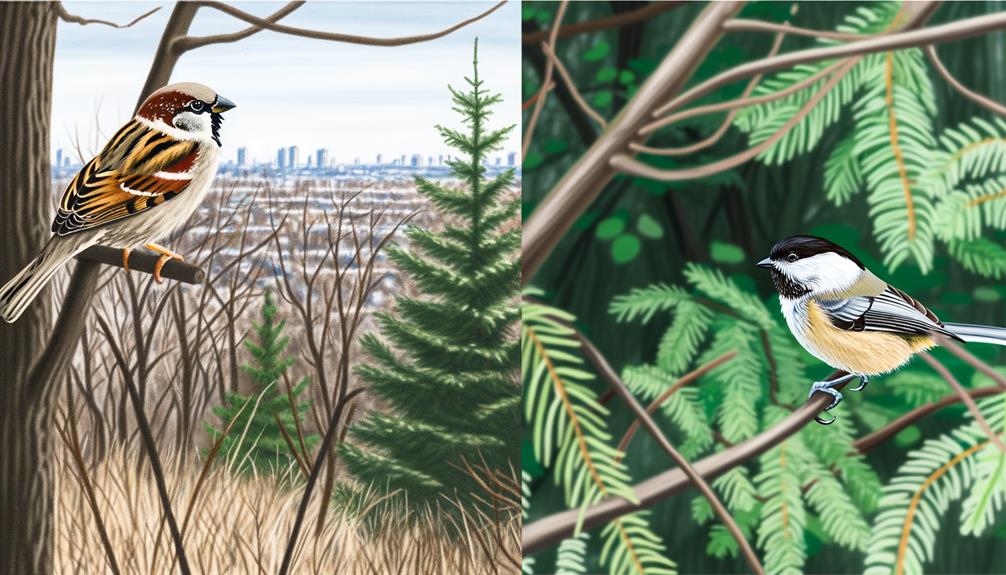
The house sparrow (Passer domesticus) is classified as a species of least concern by the IUCN, indicating a stable population despite regional declines. Conversely, chickadees, such as the black-capped chickadee (Poecile atricapillus), are also listed as least concern but face different challenges.
Detailed observations highlight:
- Habitat fragmentation: Both species encounter habitat loss, yet chickadees adapt better to fragmented forests.
- Food availability: House sparrows thrive in urban areas with abundant food; chickadees rely on diverse insect populations.
- Climate change: Chickadees' range shifts northward due to warming temperatures, while house sparrows remain more stationary.
- Human interaction: House sparrows benefit from human structures for nesting, whereas chickadees depend on natural cavities.
Despite these challenges, both species exhibit resilience.
Conclusion
To sum up, house sparrows and chickadees display unique physical traits, behaviors, and habitat preferences. Notably, house sparrows can be distinguished by their average wingspan of 7.5-9.8 inches, whereas chickadees measure approximately 6-8 inches.
Both types of birds engage distinctively with humans and encounter different conservation obstacles. By grasping these avian distinctions, one can gain a deeper understanding of their specific functions within ecosystems.
The intricate behaviors and vocalizations of both species underscore the intricate and varied nature of avian life.

